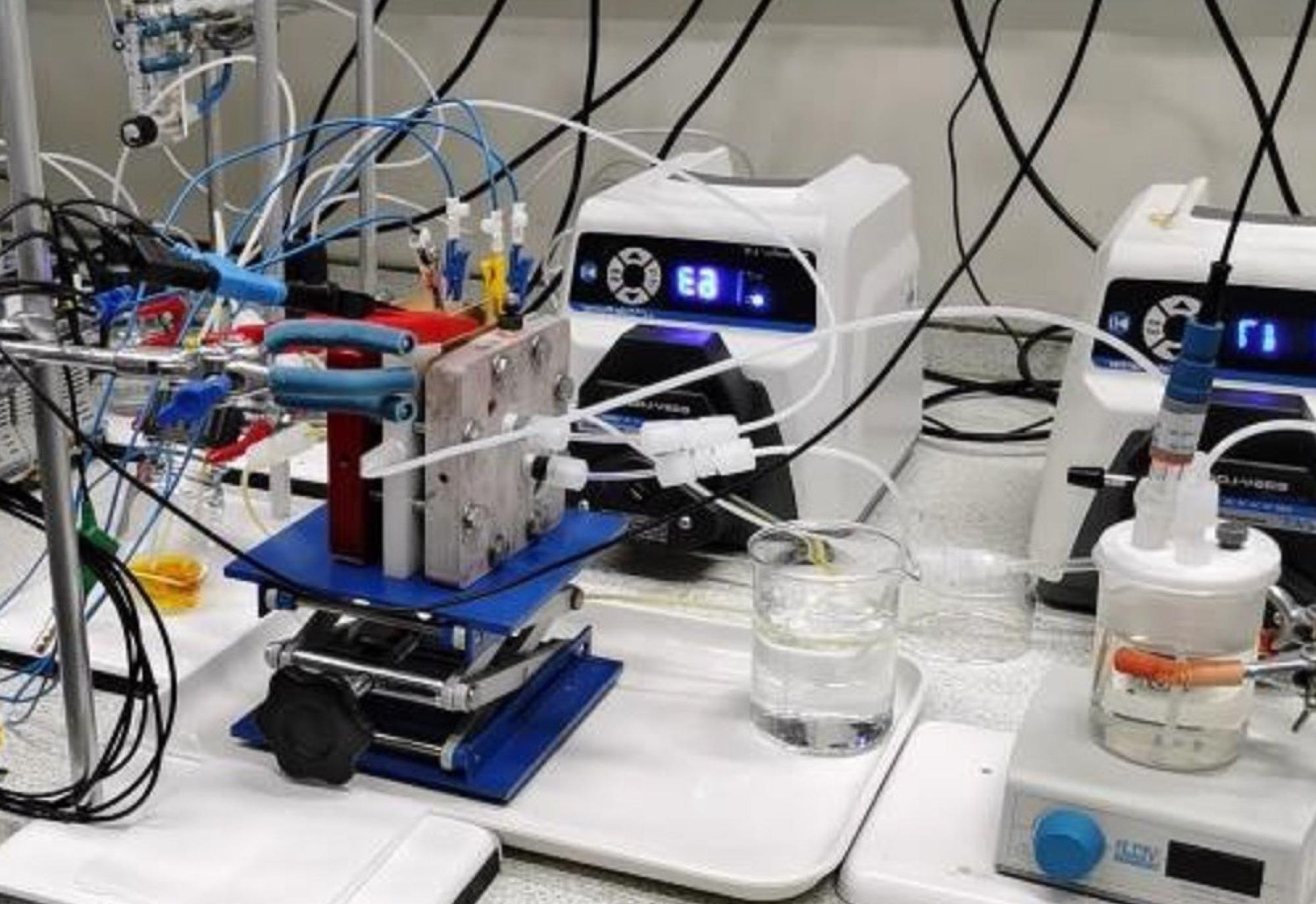Reviewed by Alex SmithMay 4 2022
According to Imperial College London investigators, a novel strategy for battery design could be the key to low-cost, long-term energy storage.
 Experimental setup of dual-membrane-structured PSA RFB. Image Credit: Imperial College London.
Experimental setup of dual-membrane-structured PSA RFB. Image Credit: Imperial College London.
The engineers and chemists have developed a polysulfide-air redox flow battery (PSA RFB) with two membranes instead of one.
The dual membrane design solves the major issues with this type of large-scale battery, allowing it to store excess energy from renewable sources like wind and solar, for instance. The findings were published in the journal Nature Communications.
Energy is stored in liquid electrolytes in redox flow batteries, which move through the cells during charge and discharge thanks to chemical reactions. The volume of the electrolyte determines the amount of energy stored, making the design presumably scalable.
But, vanadium, the electrolyte generally used in traditional redox flow batteries, is costly and primarily sourced from either Russia or China.
A Problem to Solve
The Imperial group, headed by Professors Nigel Brandon and Anthony Kucernak, has been working on alternatives that employ less expensive, readily available materials. In this case, polysulfide (sulfur dissolved in an alkaline solution) and air are used as an electrolyte and a gas, respectively.
However, the effectiveness of polysulfide-air batteries is constrained because no membrane can completely facilitate chemical reactions while restricting polysulfide from crossing into the other part of the cell.
If the polysulfide crosses over into the air side, then you lose material from one side, which reduces the reaction taking place there and inhibits the activity of the catalyst on the other. This reduces the performance of the battery—so it was a problem we needed to solve.
Dr. Mengzheng Ouyang, Department of Earth Science and Engineering, Imperial College London
The investigators devised an alternative that involved separating the polysulfide from the air using two membranes separated by a sodium hydroxide solution. The design’s positive aspect is that all materials, including membranes, are relatively inexpensive and widely available, and the design allows for a much wider range of materials to be used.
Assessing Cost
The new model was able to provide considerably more power, up to 5.8 milliwatts per centimeter squared, when compared to the better-obtained results from a polysulfide-air redox flow battery.
As cost is such an important consideration for long-term and large-scale storage, the group also conducted a cost analysis. They estimated the energy cost to be around $2.5 per kilowatt-hour, based on the price of the storage materials concerning the amount of energy stored.
The power cost was noted to be around $1600 per kilowatt, based on the rate of charge and discharge attained in relation to the price of the membranes and catalysts in the cell. Although this is way higher than what is suitable for large-scale energy storage, the researchers believe that further advancements are possible.
Our dual-membrane approach is very exciting as it opens up many new possibilities, for both this and other batteries. To make this cost-effective for large-scale storage, a relatively modest improvement in performance would be required, which could be achieved by changes to the catalyst to increase its activity or by further improvements in the membranes used.
Nigel Brandon, Professor and Dean, Faculty of Engineering, Imperial College London
Pressing Need
The research is already underway within the team, through Professor Anthony Kucernak of the Department of Chemistry's expertise in catalysts, and Dr. Qilei Song of the Department of Chemical Engineering's researching membrane technology.
Once the advancements are made, the spin-off company RFC Power Ltd, which was founded to create long-duration storage of renewable energy based on the team’s research, is set to commercialize this new design.
There is a pressing need for new ways to store renewable energy over days, weeks, or even months at a reasonable cost. This research shows a way to make that possible through improved performance and low-cost materials.
Tim Von Werne, CEO, RFC Power Ltd
The study is financially supported by the UK Research and Innovation Engineering and Physical Sciences Research Council, and the European Research Council.
Journal Reference:
Xia, Y., et al. (2022) A cost-effective alkaline polysulfide-air redox flow battery enabled by a dual-membrane cell architecture. Nature Communications. doi.org/10.1038/s41467-022-30044-w.